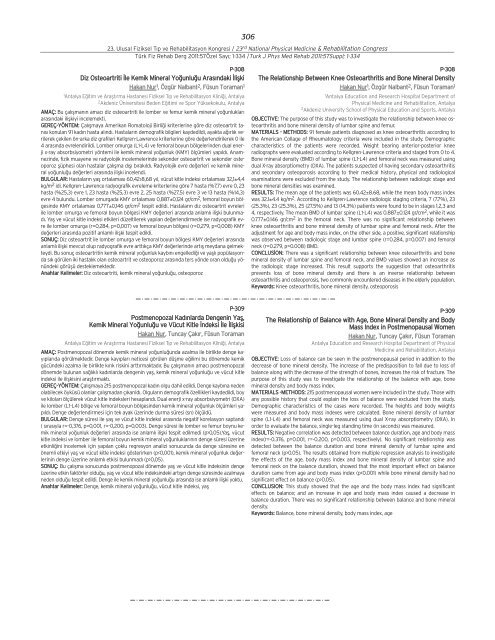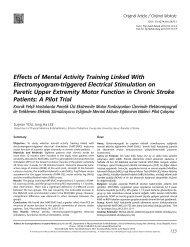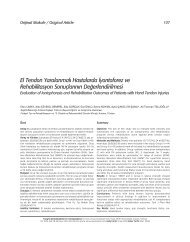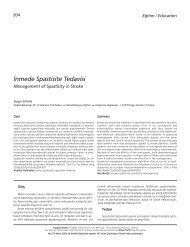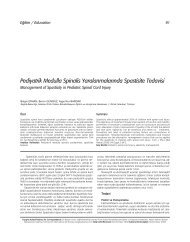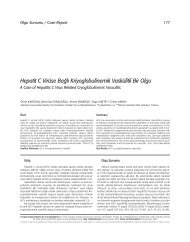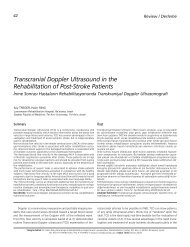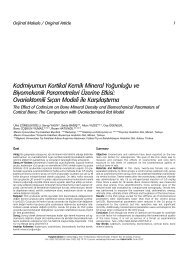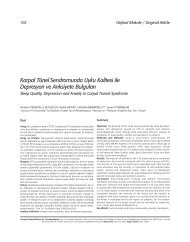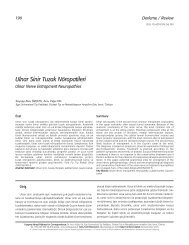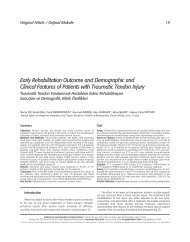Postmenopozal Kad›nlarda Vücut Kitle ‹ndeksinin ... - FTR Dergisi
Postmenopozal Kad›nlarda Vücut Kitle ‹ndeksinin ... - FTR Dergisi
Postmenopozal Kad›nlarda Vücut Kitle ‹ndeksinin ... - FTR Dergisi
Create successful ePaper yourself
Turn your PDF publications into a flip-book with our unique Google optimized e-Paper software.
P-308<br />
Diz Osteoartriti ‹le Kemik Mineral Yo¤unlu¤u Aras›ndaki ‹liflki<br />
Hakan Nur 1, Özgür Nalbant 2, Füsun Toraman 1<br />
1 Antalya E¤itim ve Araflt›rma Hastanesi Fiziksel T›p ve Rehabilitasyon Klini¤i, Antalya<br />
2 Akdeniz Üniversitesi Beden E¤itimi ve Spor Yüksekokulu, Antalya<br />
AMAÇ: Bu çal›flman›n amac› diz osteoartriti ile lomber ve femur kemik mineral yo¤unluklar›<br />
aras›ndaki iliflkiyi incelemekti.<br />
GEREÇ-YÖNTEM: Çal›flmaya Amerikan Romatoloji Birli¤i kriterlerine göre diz osteoartrit tan›s›<br />
konulan 91 kad›n hasta al›nd›. Hastalar›n demografik bilgileri kaydedildi, ayakta a¤›rl›k verilerek<br />
çekilen ön-arka diz grafileri Kellgren-Lawrence kriterlerine göre de¤erlendirilerek 0 ile<br />
4 aras›nda evrelendirildi. Lomber omurga (L1-L4) ve femoral boyun bölgelerinden dual enerji<br />
x-ray absorbsiyometri yöntemi ile kemik mineral yo¤unluk (KMY) ölçümleri yap›ld›. Anamnezinde,<br />
fizik muayene ve radyolojik incelemelerinde sekonder osteoartrit ve sekonder osteoporoz<br />
flüphesi olan hastalar çal›flma d›fl› b›rak›ld›. Radyolojik evre de¤erleri ve kemik mineral<br />
yo¤unlu¤u de¤erleri aras›nda iliflki incelendi.<br />
BULGULAR: Hastalar›n yafl ortalamas› 60,42±8,68 y›l, vücut kitle indeksi ortalamas› 32,1±4,4<br />
kg/m 2 idi. Kellgren-Lawrence radyografik evreleme kriterlerine göre 7 hasta (%7,7) evre 0, 23<br />
hasta (%25,3) evre 1, 23 hasta (%25,3) evre 2, 25 hasta (%27,5) evre 3 ve 13 hasta (%14,3)<br />
evre 4 bulundu. Lomber omurgada KMY ortalamas› 0,887±0,124 gr/cm 2 , femoral boyun bölgesinde<br />
KMY ortalamas› 0,777±0,146 gr/cm 2 tespit edildi. Hastalar›n diz osteoartrit evreleri<br />
ile lomber omurga ve femoral boyun bölgesi KMY de¤erleri aras›nda anlaml› iliflki bulunmad›.<br />
Yafl ve vücut kitle indeksi etkileri düzeltilerek yap›lan de¤erlendirmede ise radyografik evre<br />
ile lomber omurga (r=0,284, p=0,007) ve femoral boyun bölgesi (r=0,279, p=0,008) KMY<br />
de¤erleri aras›nda pozitif anlaml› iliflki tespit edildi.<br />
SONUÇ: Diz osteoartrit ile lomber omurga ve femoral boyun bölgesi KMY de¤erleri aras›nda<br />
anlaml› iliflki mevcut olup radyografik evre artt›kça KMY de¤erlerinde art›fl meydana gelmekteydi.<br />
Bu sonuç osteoartritin kemik mineral yo¤unluk kayb›n› engelledi¤i ve yafll› popülasyonda<br />
s›k görülen iki hastal›k olan osteoartrit ve osteoporoz aras›nda ters yönde oran oldu¤u yönündeki<br />
görüflü desteklemektedir.<br />
Anahtar Kelimeler: Diz osteoartriti, kemik mineral yo¤unlu¤u, osteoporoz<br />
P-309<br />
<strong>Postmenopozal</strong> <strong>Kad›nlarda</strong> Dengenin Yafl,<br />
Kemik Mineral Yo¤unlu¤u ve <strong>Vücut</strong> <strong>Kitle</strong> ‹ndeksi ‹le ‹liflkisi<br />
Hakan Nur, Tuncay Çak›r, Füsun Toraman<br />
Antalya E¤itim ve Araflt›rma Hastanesi Fiziksel T›p ve Rehabilitasyon Klini¤i, Antalya<br />
AMAÇ: <strong>Postmenopozal</strong> dönemde kemik mineral yo¤unlu¤unda azalma ile birlikte denge kay›plar›da<br />
görülmektedir. Denge kay›plar› neticesi görülen düflme e¤ilimi bu dönemde kemik<br />
gücündeki azalma ile birlikte k›r›k riskini artt›rmaktad›r. Bu çal›flman›n amac› postmenopozal<br />
dönemde bulunan sa¤l›kl› kad›nlarda dengenin yafl, kemik mineral yo¤unlu¤u ve vücut kitle<br />
indeksi ile iliflkisini araflt›rmakt›.<br />
GEREÇ-YÖNTEM: Çal›flmaya 215 postmenopozal kad›n olgu dahil edildi. Denge kayb›na neden<br />
olabilecek öyküsü olanlar çal›flmadan ç›kar›ld›. Olgular›n demografik özellikleri kaydedildi, boy<br />
ve kilolar› ölçülerek vücut kitle indeksleri hesapland›. Dual enerji x-ray absorbsiyometri (DXA)<br />
ile lomber (L1-L4) bölge ve femoral boyun bölgesinden kemik mineral yo¤unluk ölçümleri yap›ld›.<br />
Denge de¤erlendirmesi için tek ayak üzerinde durma süresi (sn) ölçüldü.<br />
BULGULAR: Denge süresi ile yafl ve vücut kitle indeksi aras›nda negatif korelasyon saptand›<br />
( s›ras›yla r=-0,376, p=0,001, r=-0,200, p=0,003). Denge süresi ile lomber ve femur boynu kemik<br />
mineral yo¤unluk de¤erleri aras›nda ise anlaml› iliflki tespit edilmedi (p>0,05).Yafl, vücut<br />
kitle indeksi ve lomber ile femoral boyun kemik mineral yo¤unluklar›n›n denge süresi üzerine<br />
etkinli¤ini incelemek için yap›lan çoklu regresyon analizi sonucunda da denge süresine en<br />
önemli etkiyi yafl ve vücut kitle indeksi gösterirken (p0,05).<br />
SONUÇ: Bu çal›flma sonucunda postmenopozal dönemde yafl ve vücut kitle indeksinin denge<br />
üzerine etkin faktörler oldu¤u, yafl ve vücut kitle indeksindeki art›fl›n denge süresinde azalmaya<br />
neden oldu¤u tespit edildi. Denge ile kemik mineral yo¤unlu¤u aras›nda ise anlaml› iliflki yoktu.<br />
Anahtar Kelimeler: Denge, kemik mineral yo¤unlu¤u, vücut kitle indeksi, yafl<br />
306<br />
23. Ulusal Fiziksel T›p ve Rehabilitasyon Kongresi / 23 rd National Physical Medicine & Rehabilitation Congress<br />
Türk Fiz Rehab Derg 2011:57Özel Say›; 1-334 /Turk J Phys Med Rehab 2011:57Suppl; 1-334<br />
P-308<br />
The Relationship Between Knee Osteoarthritis and Bone Mineral Density<br />
Hakan Nur 1, Özgür Nalbant 2, Füsun Toraman 1<br />
1 Antalya Education and Research Hospital Department of<br />
Physical Medicine and Rehabilitation, Antalya<br />
2 Akdeniz University School of Physical Education and Sports, Antalya<br />
OBJECTIVE: The purpose of this study was to investigate the relationship between knee osteoarthritis<br />
and bone mineral density of lumbar spine and femur.<br />
MATERIALS - METHODS: 91 female patients diagnosed as knee osteoarthritis according to<br />
the American Collage of Rheumatology criteria were included in the study. Demographic<br />
characteristics of the patients were recorded. Weight bearing anterior-posterior knee<br />
radiographs were evaluated according to Kellgren-Lawrence criteria and staged from 0 to 4.<br />
Bone mineral density (BMD) of lumbar spine (L1-L4) and femoral neck was measured using<br />
dual X-ray absorptiometry (DXA). The patients suspected of having secondary osteoarthritis<br />
and secondary osteoporosis according to their medical history, physical and radiological<br />
examinations were excluded from the study. The relationship between radiologic stage and<br />
bone mineral densities was examined.<br />
RESULTS: The mean age of the patients was 60.42±8.68, while the mean body mass index<br />
was 32.1±4.4 kg/m 2 . According to Kellgren-Lawrence radiologic staging criteria, 7 (7.7%), 23<br />
(25.3%), 23 (25.3%), 25 (27.5%) and 13 (14.3%) patients were found to be in stages 1,2,3 and<br />
4, respectively. The mean BMD of lumbar spine (L1-L4) was 0.887±0.124 gr/cm 2 , while it was<br />
0.777±0.146 gr/cm 2 in the femoral neck. There was no significant relationship between<br />
knee osteoarthritis and bone mineral density of lumbar spine and femoral neck. After the<br />
adjustment for age and body mass index, on the other side, a positive, significant relationship<br />
was observed between radiologic stage and lumbar spine (r=0.284, p=0.007) and femoral<br />
neck (r=0.279, p=0.008) BMD.<br />
CONCLUS‹ON: There was a significant relationship between knee osteoarthritis and bone<br />
mineral density of lumbar spine and femoral neck, and BMD values showed an increase as<br />
the radiologic stage increased. This result supports the suggestion that osteoarthritis<br />
prevents loss of bone mineral density and there is an inverse relationship between<br />
osteoarthritis and osteoporosis, two commonly encountered diseases in the elderly population.<br />
Keywords: Knee osteoarthritis, bone mineral density, osteoporosis<br />
P-309<br />
The Relationship of Balance with Age, Bone Mineral Density and Body<br />
Mass Index in Postmenopausal Women<br />
Hakan Nur, Tuncay Çak›r, Füsun Toraman<br />
Antalya Education and Research Hospital Department of Physical<br />
Medicine and Rehabilitation, Antalya<br />
OBJECTIVE: Loss of balance can be seen in the postmenopausal period in addition to the<br />
decrease of bone mineral density. The increase of the predisposition to fall due to loss of<br />
balance along with the decrease of the strength of bones, increases the risk of fracture. The<br />
purpose of this study was to investigate the relationship of the balance with age, bone<br />
mineral density and body mass index.<br />
MATERIALS -METHODS: 215 postmenopausal women were included in the study. Those with<br />
any possible history that could explain the loss of balance were excluded from the study.<br />
Demographic characteristics of the cases were recorded. The heights and body weights<br />
were measured and body mass indexes were calculated. Bone mineral density of lumbar<br />
spine (L1-L4) and femoral neck was measured using dual X-ray absorptiometry (DXA). In<br />
order to evaluate the balance, single-leg standing time (in seconds) was measured.<br />
RESULTS: Negative correlation was detected between balance duration, age and body mass<br />
index(r=-0.376, p=0.001, r=-0.200, p=0.003, respectively). No significant relationship was<br />
detected between the balance duration and bone mineral density of lumbar spine and<br />
femoral neck (p>0.05). The results obtained from multiple regression analysis to investigate<br />
the effects of the age, body mass index and bone mineral density of lumbar spine and<br />
femoral neck on the balance duration, showed that the most important effect on balance<br />
duration came from age and body mass index (p0.05).<br />
CONCLUSION: This study showed that the age and the body mass index had significant<br />
effects on balance; and an increase in age and body mass index caused a decrease in<br />
balance duration. There was no significant relationship between balance and bone mineral<br />
density.<br />
Keywords: Balance, bone mineral density, body mass index, age


